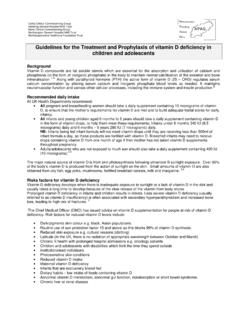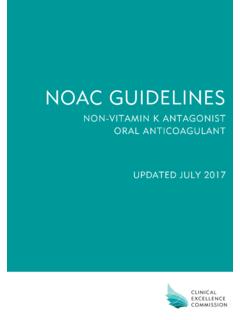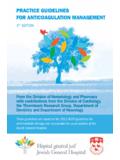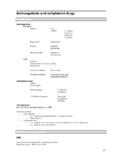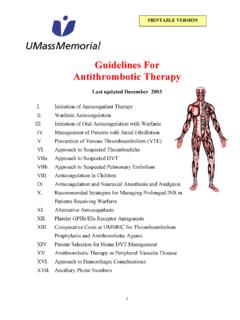Transcription of GUIDELINES FOR TUBERCULOSIS PREVENTIVE …
1 1 GUIDELINES FOR TUBERCULOSIS PREVENTIVE therapy AMONG HIV INFECTED INDIVIDUALS IN SOUTH AFRICA 2010 2 TB prophylaxis GUIDELINES FOR TUBERCULOSIS PREVENTIVE therapy AMONG HIV INFECTED INDIVIDUALS Background The dramatic spread of the HIV epidemic throughout sub-Saharan Africa in the past decades has been accompanied by up to a fourfold increase in the number of TB cases registered by national TB programmes. Strategies to control TUBERCULOSIS must now include interventions to reduce HIV infection. On the other hand, it is estimated that around 70% of new adult cases of TUBERCULOSIS in South Africa are co-infected with HIV. TUBERCULOSIS is the commonest cause of morbidity and mortality among HIV-infected persons in South Africa and studies have shown that TUBERCULOSIS accelerates HIV disease progression.
2 Therefore, preventing TUBERCULOSIS among HIV infected persons, where correctly implemented, should be offered to people living with HIV/AIDS. While TB PREVENTIVE therapy may not reduce the incidence of TUBERCULOSIS in the community, it prevents morbidity and mortality attributable to TB at an individual level. TB PREVENTIVE therapy is the administration of one or more antituberculosis drugs to individuals with latent infection with M. TUBERCULOSIS in order to prevent progression to active TB disease. Trials have shown that maximum benefits from TB PREVENTIVE therapy are achieved in HIV-infected persons with evidence of TUBERCULOSIS infection as demonstrated by a positive tuberculin skin test. In these patients, the risk of developing TUBERCULOSIS is reduced by approximately 60% and their survival is also prolonged.
3 However, benefit has also been shown among HIV-infected persons in general, regardless of their tuberculin test result. 3TB PREVENTIVE therapy and Health Services TB PREVENTIVE therapy is an intervention that should be part of the package of care for people living with HIV/AIDS. TB PREVENTIVE therapy should only be offered if the following prerequisites have been met: High quality voluntary counselling and rapid testing for HIV is available. Patients are screened for active TB disease before initiation of TB PREVENTIVE therapy . Providers follow up and monitor patients monthly to encourage adherence, address side-effects and exclude active TB disease. The HIV/AIDS programme takes responsibility for implementing TB PREVENTIVE therapy . There is strong collaboration between HIV/AIDS and TB programmes.
4 Data is collected on o the number of people who are started on IPT o The number of people who complete 6 months of IPT o The number of people who develop active TB when taking IPT In order to provide comprehensive care to HIV/AIDS patients, TB PREVENTIVE therapy must be rolled out to all public health services. Sites that already provide TB PREVENTIVE therapy should be consulted to gain from local experience. Exclusion of Active TUBERCULOSIS It is essential to exclude active TUBERCULOSIS in every patient prior to starting PREVENTIVE therapy . This is critical in order to avoid giving one antituberculosis drug to patients with TB disease who require a full treatment regimen. Prior to initiation of TB PREVENTIVE therapy , patients should be screened for signs and symptoms of active TB disease: Current cough (24hrs or longer) Fever Loss of weight Drenching night sweats All patients with 1 or more sign or symptom are considered TB suspect and must be further investigated for active TB disease as per national TB GUIDELINES .
5 They are not eligible for TB PREVENTIVE therapy until active TB disease has been excluded on the basis of sputum smear microscopy and mycobacterial culture. The role of chest x-ray in excluding active TB prior to initiation of TB PREVENTIVE therapy remains unclear and is an additional barrier to access. Although chest x-ray is not recommended for excluding active TB disease prior to initiation of TB PREVENTIVE therapy , it still has a role in working up TB suspects with negative sputum smears as per the national TB GUIDELINES . To exclude active TB prior to initiation of TB PREVENTIVE therapy , the emphasis should be on collecting sputum samples for microscopy and mycobacterial culture and, where indicated, investigations for extrapulmonary TB. IF THERE IS ANY SUSPICION THAT THE PATIENT HAS ACTIVE TB THE PATIENT SHOULD NOT BE STARTED ON IPT!
6 4 Eligibility for TB PREVENTIVE therapy Clinical trials have shown that the benefit of TB PREVENTIVE therapy is greatest in HIV-infected persons with a positive tuberculin skin test. Where tuberculin tests are feasible and can be performed, IPT should only be offered to those who are TST positive. However, the practicalities and logistics of doing a tuberculin skin test are often an obstacle for provision of TB PREVENTIVE therapy . Therefore the tuberculin skin test is no longer required to identify HIV infected people eligible for IPT. Considering the high prevalence of TB infection in South Africa, all HIV infected people with no signs or symptoms suggestive of active TB are eligible for TB PREVENTIVE therapy . Note that the following populations are at particularly high risk of developing TB and would benefit from IPT: miners, prisoners, TB contacts, health care workers and children.
7 Patients with signs and symptoms suggestive of TB must be investigated for TB (see flow chart). If they are found not to have TB (smear and culture are both negative), they should be reassessed in three months, and if no longer symptomatic, should be offered TB PREVENTIVE therapy . IPT and Pregnancy: yes HIV positive TB cases cause 10% or maternal deaths in Africa. Active TB during pregnancy is associated with spontaneous abortions, and adverse perinatal outcomes. Expert opinion is that that the benefits of TB PREVENTIVE therapy for eligible pregnant women, after exclusion of active TUBERCULOSIS disease, outweigh the risks. TB PREVENTIVE therapy can be started at any time during pregnancy and IPT should be completed if a woman falls pregnant while taking IPT. IPT and ART Although ART dramatically reduces the risk of TB, patients on ART are still at increased risk of developing TB compared to HIV-negative people.
8 The risk is highest in the first 6 months after initiating ART and often occurs in the setting of immune reconstitution inflammatory syndrome (IRIS). It is therefore critical to ensure systematic TB screening before initiating ART and during the initial 6 months of ART. Patients who are receiving IPT and who are eligible for ART should complete their IPT while taking ART. IPT should not be stopped because they have started ART. There is evidence that IPT is well tolerated in patients on ART. Retrospective cohort studies indicate additional benefits of providing IPT to patients during ART. Because the evidence is not based on randomised controlled trials, providing IPT to patients on ART has a conditional recommendation. Once TB has been excluded, IPT can be provided to patients during ART. Patients on d4T and INH may be at increased risk for peripheral neuropathy and those on NVP and INH may be at increased risk for hepatotoxicity.
9 Patients on IPT who start ART should be monitored clinically, and INH stopped immediately if there is evidence of severe peripheral neuropathy or hepatotoxicity. 5 IPT in patients previously treated for TB IPT provides benefit to patients who successfully complete TB treatment. IPT can be started after successful completion of TB treatment or at any time after a previous episode of TB, provided that active TB disease is excluded. Note that eligible patients should be counselled thoroughly Who is Not Eligible for TB PREVENTIVE therapy ? Patients with signs and/or symptoms of TB Patients with active liver disease or who are actively abusing alcohol should not be offered TB PREVENTIVE therapy because of the risk of hepatotoxicity . Recommended Regimen The standard regimen for TB PREVENTIVE therapy is: Adults: Isoniazid (INH) 5 mg/kg/day (maximum 300 mg per day).
10 Children: Isoniazid (INH) 10 mg/kg/day (maximum 300 mg per day). Vitamin B6 (pyridoxine) 25 mg per day should be given concomitantly with isoniazid to prevent the occurrence of peripheral neuropathy. The recommended duration is: 6 months of continuous treatment (can be completed over 9 months). If a patient has an interruption in TB PREVENTIVE therapy for no more than three months, he/she can be restarted if still asymptomatic. TB PREVENTIVE therapy should be given once only. The protective effect of TB PREVENTIVE therapy is expected to last for approximately 18 months. 6 When and How to Start Information about TUBERCULOSIS , including PREVENTIVE therapy , should be made available to all people living with HIV/AIDS. Experiences from trials and operational research have stressed the importance of relevant information for the patients including the issue of adherence.










